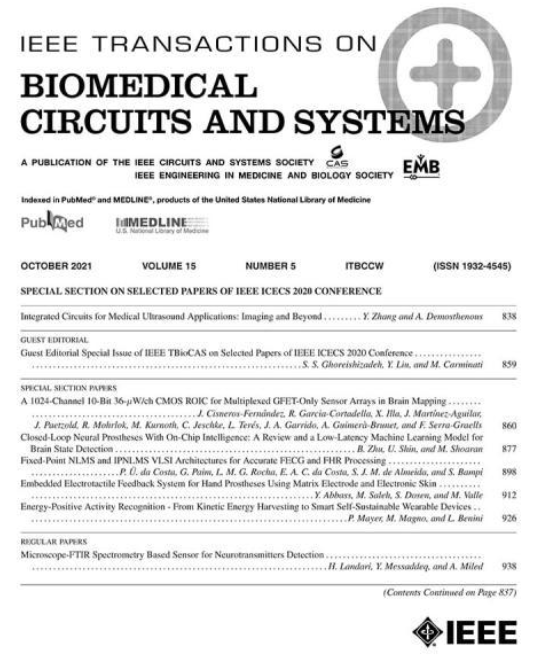A 200-Channel Area-Power-Efficient Chemical and Electrical Dual-Mode Acquisition IC for the Study of Neurodegenerative Diseases
IF 4.9
2区 医学
Q2 ENGINEERING, BIOMEDICAL
IEEE Transactions on Biomedical Circuits and Systems
Pub Date : 2016-06-01
DOI:10.1109/TBCAS.2015.2468052
引用次数: 37
Abstract
Microelectrode array (MEA) can be used in the study of neurodegenerative diseases by monitoring the chemical neurotransmitter release and the electrical potential simultaneously at the cellular level. Currently, the MEA technology is migrating to more electrodes and higher electrode density, which raises power and area constraints on the design of acquisition IC. In this paper, we report the design of a 200-channel dual-mode acquisition IC with highly efficient usage of power and area. Under the constraints of target noise and fast settling, the current channel design saves power by including a novel current buffer biased in discrete time (DT) before the TIA (transimpedance amplifier). The 200 channels are sampled at 20 kS/s and quantized by column-wise SAR ADCs. The prototype IC was fabricated in a 0.18 μm CMOS process. Silicon measurements show the current channel has 21.6 pArms noise with cyclic voltammetry (CV) and 0.48 pArms noise with constant amperometry (CA) while consuming 12.1 μW. The voltage channel has 4.07 μVrms noise in the bandwidth of 100 kHz and 0.2% nonlinearity while consuming 9.1 μW. Each channel occupies 0.03 mm2 area, which is among the smallest.用于神经退行性疾病研究的200通道区域节能化学和电双模式采集集成电路
微电极阵列(MEA)通过在细胞水平上同时监测化学神经递质释放和电势,可用于神经退行性疾病的研究。目前,MEA技术正在向更多电极和更高电极密度的方向迁移,这对采集IC的设计提出了功率和面积的限制。在本文中,我们报告了一种200通道双模采集IC的设计,具有高效的功率和面积利用率。在目标噪声和快速沉降的约束下,电流通道设计通过在TIA(跨阻放大器)前加入一个新颖的离散时间(DT)偏置电流缓冲器来节省功率。200个通道以20ks /s的速度采样,并通过列式SAR adc进行量化。原型IC采用0.18 μm CMOS工艺制作。硅测量表明,电流通道功耗为12.1 μW,循环伏安法(CV)噪声为21.6 pArms,恒安培法(CA)噪声为0.48 pArms。该电压通道在100 kHz带宽下噪声为4.07 μVrms,非线性为0.2%,功耗为9.1 μW。每个通道的面积为0.03 mm2,是最小的通道之一。
本文章由计算机程序翻译,如有差异,请以英文原文为准。
求助全文
约1分钟内获得全文
求助全文
来源期刊

IEEE Transactions on Biomedical Circuits and Systems
工程技术-工程:电子与电气
CiteScore
10.00
自引率
13.70%
发文量
174
审稿时长
3 months
期刊介绍:
The IEEE Transactions on Biomedical Circuits and Systems addresses areas at the crossroads of Circuits and Systems and Life Sciences. The main emphasis is on microelectronic issues in a wide range of applications found in life sciences, physical sciences and engineering. The primary goal of the journal is to bridge the unique scientific and technical activities of the Circuits and Systems Society to a wide variety of related areas such as: • Bioelectronics • Implantable and wearable electronics like cochlear and retinal prosthesis, motor control, etc. • Biotechnology sensor circuits, integrated systems, and networks • Micropower imaging technology • BioMEMS • Lab-on-chip Bio-nanotechnology • Organic Semiconductors • Biomedical Engineering • Genomics and Proteomics • Neuromorphic Engineering • Smart sensors • Low power micro- and nanoelectronics • Mixed-mode system-on-chip • Wireless technology • Gene circuits and molecular circuits • System biology • Brain science and engineering: such as neuro-informatics, neural prosthesis, cognitive engineering, brain computer interface • Healthcare: information technology for biomedical, epidemiology, and other related life science applications. General, theoretical, and application-oriented papers in the abovementioned technical areas with a Circuits and Systems perspective are encouraged to publish in TBioCAS. Of special interest are biomedical-oriented papers with a Circuits and Systems angle.
 求助内容:
求助内容: 应助结果提醒方式:
应助结果提醒方式:


